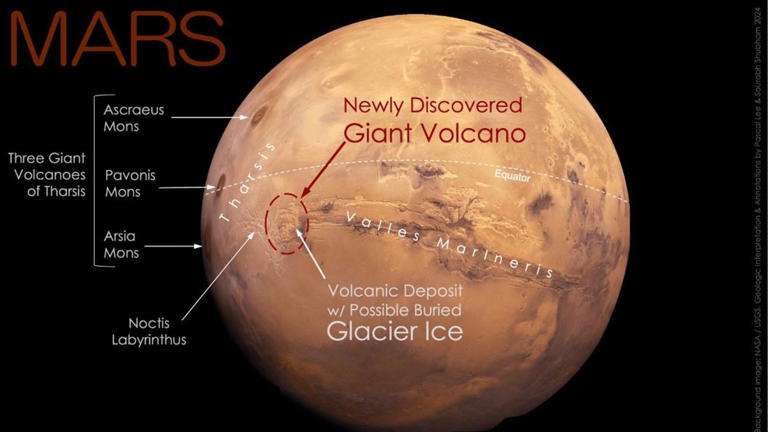Discover the Mars geological scar, a colossal feature larger than the Grand Canyon, cutting through the Tharsis volcanic region. Explore its formation and the mysteries it reveals about Mars’ ancient past.

© Provided by Indy 100
Mars Geological Scar: Unveiling a Massive Martian Feature
Mars, the red planet in our solar system, holds secrets that continue to astound scientists. Recently, the European Space Agency (ESA) uncovered a monumental discovery: the Mars geological scar known as Aganippe Fossa. Stretching an impressive 600 kilometers, this scar dwarfs even the Grand Canyon on Earth. It slices through the rugged terrain at the base of Arsia Mons, one of Mars’ largest volcanoes.
Exploring Aganippe Fossa: A Glimpse into Martian History
The discovery of Aganippe Fossa has sparked intrigue among scientists. This immense scar is believed to have formed due to volcanic activity beneath the Tharsis volcanic region. Over time, as magma pushed upwards, it stretched and cracked Mars’ crust, leaving behind this massive geological feature. The ESA’s Mars Express mission, orbiting the planet since 2003, has been instrumental in capturing detailed images of Mars’ surface, revealing its diverse and ancient landscapes.
Terrain Diversity: Insights from Mars Express
Mars Express has provided unprecedented insights into the diverse terrains surrounding Aganippe Fossa. Among these are hummocky terrains, characterized by irregular mounds and valleys clustered together, and lobate terrains made of rocky debris and gentle cliffs. These features are believed to be remnants of ancient geological processes shaped by Mars’ turbulent history.
Aureole of Arsia Mons: Ancient Glacial Features
One of the intriguing aspects captured by Mars Express is Arsia Mons’ ring-shaped aureole, spanning over 100,000 square kilometers around the volcano’s base. This aureole, possibly associated with ancient glaciers, has developed predominantly on the northwestern flank of Arsia Mons. Scientists speculate that prevailing winds on Mars played a crucial role in determining where ice settled over millennia.
Wind and Dust: Shaping Martian Landscapes
Windblown dust and sand have also played a significant role in shaping the Martian landscape around Aganippe Fossa. These natural forces have created distinctive patterns, resembling zebra stripes, where darker material contrasts sharply with lighter ground. Evidence of ancient lava flows further adds to the geological tapestry of this region, dating back to the active periods of Arsia Mons.
Implications for Martian Geology: Understanding Mars’ Past
Studying Aganippe Fossa and its surroundings offers valuable insights into Mars’ geological evolution. The scar’s formation provides clues about the planet’s early history and the processes that shaped its surface over billions of years. By analyzing these geological features, scientists can better understand Mars’ volcanic activity, climate history, and potential for past habitability.
Future Exploration and Discoveries
As technology advances and missions like Mars Express continue to explore the red planet, more discoveries await. Each new finding, whether a geological scar or ancient terrain, adds another piece to the puzzle of Mars’ past. These discoveries not only deepen our understanding of Mars but also pave the way for future human exploration and potential colonization efforts.
Conclusion
The Mars geological scar, Aganippe Fossa, stands as a testament to the dynamic forces that have shaped the red planet. Stretching across the Tharsis volcanic region, this colossal feature offers a glimpse into Mars’ tumultuous past. Through missions like Mars Express, scientists are unraveling the mysteries of Aganippe Fossa and its implications for our understanding of planetary evolution. As we continue to explore Mars, we can expect more groundbreaking discoveries that redefine our perception of our neighboring planet.
ALSO READ:
Gravitational Lensing: 5 Incredible Discoveries You Won’t Believe